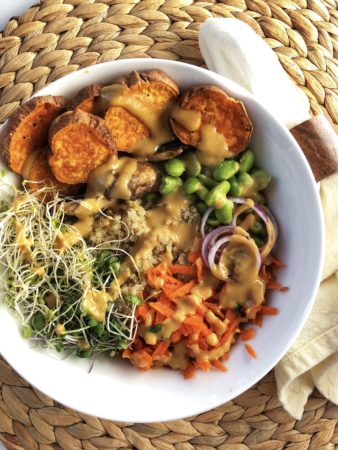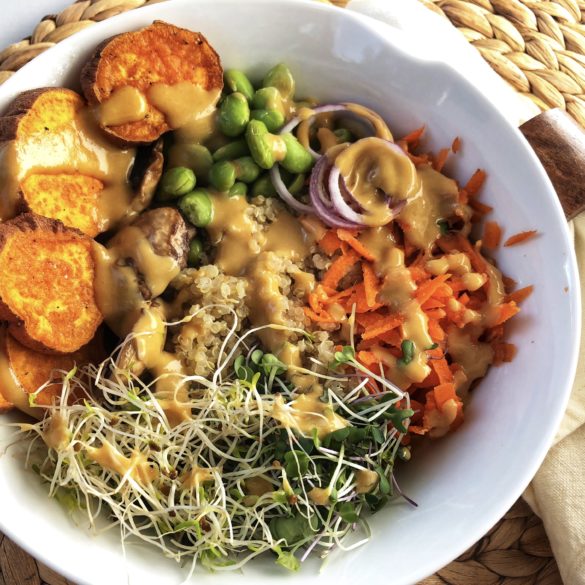It has been a busy week here! We had friends in from Calgary, have been getting our community garden planted for the season, doing projects around the house, spring cleaning and trying to find our eldest a used car to purchase with her savings. I keep thinking, I need to post! There are so many things to post about and so many great recipes to share! Today I want to share some information on fibre with you as well as a Power Bowl recipe perfect for these warmer spring dinners.
I am currently taking an online course through E-Cornell University called Nutrition and the Digestive System. It is pretty fascinating actually. Not only are we studying the physical body and the digestive system, but we are also learning to properly analyze nutrition claims that we may read online. And there sure are a lot of them out there! “Low carb”,” low fat”, “sugar-free”, “milk grows strong bones”, “Frosted Mini-Wheats: clinically shown to improve kids’ attentiveness by nearly 20 percent.” Really!? It is easy to get sucked into marketing campaigns. It looks good, sounds easy and helps us rationalize our diet weaknesses. Now, I am no nutritionist, but it is pretty easy to realize that food that comes directly from the earth is going to be the best for our bodies.
One of the most serious problems faced by our current population is that we are generally not getting enough fibre in our diets. Did you know that there is NO fibre in animal products? So, any time you eat meat, cheese, milk, fish, or eggs, you are not getting any fibre. The same is true for most junk food. You are of course then reducing the amount of fibre rich foods that will reach your stomach. There simply aren’t that many more times you will be reaching for fruits and veggies, legumes, nuts and seeds if you are eating a lot of the non-fiber containing foods.
Government regulations are so lax that nearly the entire U.S. population eats a diet that is “in crisis” according to the stats found by Dr. Greger. Who are we kidding, we aren’t that much different from the U.S. up here in Canada!
Here is a 3 minute video discussing this very problem:
Thankfully, for every problem there is a solution. And it is a simple one.
Dr. Greger is quoted in his short article here on fibre. – “Accumulating evidence indicates that greater dietary fiber intakes reduce risk for type 2 diabetes, cardiovascular disease, certain cancers, weight gain, obesity, and diverticular disease, as well as functional constipation. So, we need to eat more fiber-rich foods, which means eating more whole grains, vegetables, fruits, and legumes (beans, split peas, chickpeas, and lentils).”
Simply put, if we keep adding fibre into our diet, until our meals are mostly plant based, we will become much healthier! If you don’t eat a lot of fresh foods now, ease in a bit, adding no more than 5 grams of fibre each day until you can work your way up. Health Canada recommends a minimum intake of 25 grams per day of fibre for women, 38 for men. And that is the bare minimum.
The doctors lecturing on the plant based eating cruise mentioned over and over… don’t worry about your protein intake. If you are eating lots of whole foods, you will be getting enough protein. Only 3% of the population is actually protein deficient-thought to be because they are on extremely calorie restricted diets and just aren’t eating enough food. 97% don’t consistently get enough fiber… what is the real problem here? Another great article “Where do you get your fibre” here.
In my course, I had to keep track of every morsel of my food consumption for 3 days. Then using the WebMD site, I figured out the amount of fibre in all of the food eaten. This is a neat tool to calculate fibre. Check it out here. I was happy to find out that over the 3 days of tracking my regular diet, my average fibre count was 50 grams! Not much wonder I’m such a ‘regular’ girl! TMI!!
Here are some fibre stats: 1/2 avocado: 6 grams, 1 banana: 4 grams, 1/2 cup lentils: 8 grams, 1 T chia seeds: 4 grams, apple: 5 grams. So if you are shooting for 30 grams of fibre per day, you can see that it doesn’t take much to get there! Please don’t forget about your kids… It is very important that they get a good amount of fibre in their diets too. This will set them up for a stronger gut and immune system for life as well as ingrained health habits. Health begins in the gut. Did you know that we have trillions of bacteria in our gut microbiome? That is more bacterial cells in our gut than we actually have human cells in our bodies!
To quote Dr. Greger: “The symbionts—the good bacteria that live in symbiosis with us—are largely nourished by fruits, vegetables, grains, and beans. Pathobionts, the disease-causing bacteria that may disrupt our microbial balance, instead appear to be fed by meat, dairy, eggs, junk food, and fast food.” Here is a 3 minute video on how eggs can adversely affect your gut health and why. Sorry if you love your eggs. They actually aren’t the “perfect food”. See! There is another marketing campaign that has us all confused!
At long last, I bring you to a great recipe that can be modified beyond belief. Basically, if you don’t like a veggie in this recipe, or you don’t think your kids will, substitute it with something they do like. Being that its a bowl, you just precook or pre-shred or chop your ingredients, pile them all together nicely in a bowl, spill on some sauce and voila! Dinner! Then left-over salad for lunch, just add some greens!
Once again this is from the “Oh She Glows” recipe book. Seriously, just buy the book and then you don’t even need me. 🙂 Next recipe is not from Angela, promise!


Ingredients
- 2 sweet potatoes, sliced into 1/2 inch rounds1 T olive or coconut oil (melted)sea salt and black pepper to taste2 cups of uncooked quinoaTo assemble bowl:2 cups frozen shelled edamame beans (thawed)2 medium carrots grated4 green or 1/2 red onion sliced thinly1/2 cup chopped cilantro2 teaspoons sesame seeds2 tablespoons hemp seeds1 cup sproutsOrange- Maple Miso dressing: 3 tablespoons miso (comes in tubs in the fridge of your local health food store)1 clove garlic (I added this in to zing it up)2 tablespoons rice vinegar1 tablespoon sesame oil1 tablespoon tahini (sesame paste)- if you don't have this, use sesame seeds1/4 cup fresh orange juice (easy to squeeze an orange for this)1 tablespoon water1 teaspoon maple syrupBlend the dressing ingredients in a food processor or blender until smooth.
Instructions
- Preheat the oven to 400 degrees. Line a baking sheet with parchment paper. Place the sweet potato round on the sheet and drizzle with oil coating both sides. Sprinkle with salt and pepper. Roast for 20 minutes then flip and roast for 10 more.
- Cook the quinoa according to package directions.
- To assemble the bowl, place the warm sweet potatoes and quinoa into bowls and top with the remainder of the ingredients. Drizzle with the Orange-Miso Dressing and dig in!
(Feel free to substitute any vegetables, nuts and seeds to enjoy to the fullest!) Don't forget sprouts are one of the healthiest things you can eat, so give them a chance. Sunflower sprouts can be a great option as they are super flavourful and you can tell your kids they are eating a baby sunflower!
www.thevibrantveggie.com


2 comments
Great looks good
Great info. and ? the sauce.
Comments are closed.